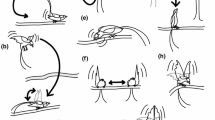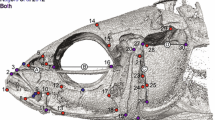Abstract
Fluctuating asymmetries are subtle random deviations from perfect symmetry in bilateral traits caused by the inability of individuals to buffer their development against the disruptive effects of genetic and environmental stresses. The degree of asymmetry of secondary sexual characters is supposed to convey information about a male's phenotypic and/or genetic quality, and females may thus be expected to use bilateral symmetry as a cue in mate choice. We independently and simultaneously manipulated the length and the relative symmetry of the pelvic spines of computer-animated three-spined sticklebacks, Gasterosteus aculeatus. In all mate choice tests involving two male models differing in spine symmetry, females preferred the symmetric model, irrespective of spine length, though only significantly so when both male models had short spines. Females did not significantly discriminate between male models differing in spine length alone. The preference for symmetry was stronger the higher the females' physical condition. Our study demonstrates that female sticklebacks master the perceptual abilities required to discriminate between potential mates basing exclusively on small length differences between paired structures, and provides experimental evidence that spine symmetry is subject to sexual selection through female choice in this species.



Similar content being viewed by others
References
Bell MA, Foster SA (1994) Introduction to the evolutionary biology of the threespine stickleback. In: Bell MA, Foster SA (eds) The evolutionary biology of the threespine stickleback. Oxford University Press, Oxford, pp 1–27
Bennett ATD, Cuthill IC, Partridge JC, Maier EJ (1996) Ultraviolet vision and mate choice in zebra finches. Nature 380:433–435
Bjorksten T, David P, Pomiankowski A, Fowler K (2000a) Fluctuating asymmetry of sexual and nonsexual traits in stalk-eyed flies: a poor indicator of developmental stress and genetic quality. J Evol Biol 13:89–97
Bjorksten TA, Fowler K, Pomiankowski A (2000b) What does sexual trait FA tell us about stress? Trends Ecol Evol 15:163–166
Bolger T, Connolly PL (1989) The selection of suitable indices for the measurement and analysis of fish condition. J Fish Biol 34:171–182
David P, Hingle A, Greig D, Rutherford A, Pomiankowski A, Fowler K (1998) Male sexual ornament size but not asymmetry reflects condition in stalk-eyed flies. Proc R Soc Lond B 265:2211–2216
Hasson O (1989) Amplifiers and the handicap principle in sexual selection: a different emphasis. Proc R Soc Lond B 235:383–406
Hasson O (1990) The role of amplifiers in sexual selection: an integration of the amplifying and the Fisherian mechanisms. Evol Ecol 4:277–289
Hoogland R, Morris D, Tinbergen N (1957) The spines of sticklebacks (Gasterosteus and Pygosteus) as means of defence against predators (Perca and Esox). Behaviour 10:205–236
Hunt J, Simmons LW (1997) Patterns of fluctuating asymmetry in beetle horns: an experimental examination of the honest signalling hypothesis. Behav Ecol Sociobiol 41:109–114
Hunt J, Simmons LW (1998) Patterns of fluctuating asymmetry in beetle horns: no evidence for reliable signaling. Behav Ecol 9:465–470
Hurlbert SH (1984) Pseudoreplication and the design of ecological field experiments. Ecol Monogr 54:187–211
Jennions MD, Petrie M (1997) Variation in mate choice and mating preferences: a review of causes and consequences. Biol Rev Camb Philos Soc 72:283–327
Künzler R, Bakker TCM (1998) Computer animations as a tool in the study of mating preferences. Behaviour 135:1137–1159
Künzler R, Bakker TCM (2001) Female preferences for single and combined traits in computer animated stickleback males. Behav Ecol 12:681–685
Ludwig W (1932) Das Rechts-Links Problem im Tierreich und beim Menschen. Springer, Berlin Heidelberg New York
Manning JT, Hartley MA (1991) Symmetry and ornamentation are correlated in the peacock's train. Anim Behav 42:1020–1021
McGregor PK (2000) Playback experiments: design and analysis. Acta Ethol 3:3–8
McGregor PK, Catchpole CK, Dabelsteen T, Falls JB, Fusani L, Gerhardt HC, Gilbert F, Horn AG, Klump GM, Kroodsma DE, Lambrechts MM, McComb KE, Nelson DA, Pepperberg IM, Ratcliffe L, Searcy WA, Weary DM (1992) Design of playback experiments: the Thornbridge Hall NATO ARW consensus. In: McGregor PK (ed) Playback and studies of animal communication. Plenum Press, New York, pp 1–9
Milinski M, Bakker TCM (1990) Female sticklebacks use male coloration in mate choice and hence avoid parasitized males. Nature 344:330–333
Møller AP (1990) Fluctuating asymmetry in male sexual ornaments may reliably reveal male quality. Anim Behav 40:1185–1187
Møller AP (1992) Female swallow preference for symmetrical male sexual ornaments. Nature 357:238–240
Møller AP, Pomiankowski A (1993a) Fluctuating asymmetry and sexual selection. Genetica 89:267–279
Møller AP, Pomiankowski A (1993b) Why have birds got multiple sexual ornaments? Behav Ecol Sociobiol 32:167–176
Møller AP, Thornhill R (1998) Bilateral symmetry and sexual selection: a meta-analysis. Am Nat 151:174–192
Morris MR, Casey K (1998) Female swordtail fish prefer symmetrical sexual signal. Anim Behav 55:33–39
Oliveira RF, Rosenthal GG, Schlupp I, McGregor PK, Cuthill IC, Endler JA, Fleishman LJ, Zeil J, Barata E, Burford F, Gonçalves D, Haley M, Jakobsson S, Jennions MD, Körner KE, Lindström L, Peake T, Pilastro A, Pope DS, Roberts SGB, Rowe C, Smith J, Waas JR (2000) Considerations on the use of video playbacks as visual stimuli: the Lisbon workshop consensus. Acta Ethol 3:61–65
Palmer AR, Strobeck C (1986) Fluctuating asymmetry: measurement, analysis, patterns. Annu Rev Ecol Syst 17:391–421
Pelkwijk JJ ter, Tinbergen N (1937) Eine reizbiologische Analyse einiger Verhaltensweisen von Gasterosteus aculeatus. Z Tierpsychol 1:193–200
Rice WR, Gaines SD (1994) Extending nondirectional heterogeneity tests to evaluate simply ordered alternative hypotheses. Proc Natl Acad Sci USA 91:225–226
Rosenthal GG (1999) Using video playback to study sexual communication. Environ Biol Fish 56:307–316
Rosenthal GG (2000) Design consideration and techniques for constructing video stimuli. Acta Ethol 3:49–54
SAS Institute (2000) JMP, Version 4. SAS Institute, Cary, N.C.
Swaddle JP (1999a) Limits to length asymmetry detection in starlings: implications for biological signalling. Proc R Soc Lond B 266:1299–1303
Swaddle JP (1999b) Visual signalling by asymmetry: a review of perceptual processes. Philos Trans R Soc Lond B 354:1383–1393
Swaddle JP, Cuthill IC (1994) Preference for symmetric males by female zebra finches. Nature 367:165–166
Symons PEK (1965) Analysis of spine-raising in the male three-spined sticklebacks. Behaviour 26:1–74
Thornhill R, Møller AP (1998) The relative importance of size and asymmetry in sexual selection. Behav Ecol 9:546–551
Van Valen L (1962) A study of fluctuating asymmetry. Evolution 16:125–142
Watson PJ, Thornhill R (1994) Fluctuating asymmetry and sexual selection. Trends Ecol Evol 9:21–25
Acknowledgements
We thank Carlo Largiadèr, Marc Zbinden and the referees for constructive comments on the manuscript, Heinz Richner for providing facilities, and the Swiss National Science Foundation for financial support. This study conforms to the legal requirements of Switzerland.
Author information
Authors and Affiliations
Corresponding author
Additional information
Communicated by J. Krause
Rights and permissions
About this article
Cite this article
Mazzi, D., Künzler, R. & Bakker, T.C.M. Female preference for symmetry in computer-animated three-spined sticklebacks, Gasterosteus aculeatus . Behav Ecol Sociobiol 54, 156–161 (2003). https://doi.org/10.1007/s00265-003-0609-0
Received:
Revised:
Accepted:
Published:
Issue Date:
DOI: https://doi.org/10.1007/s00265-003-0609-0




